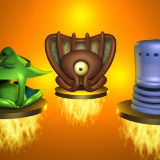Game Review: Garden Story · 3:53am Sep 8th, 2022
Game Title: Garden Story
Released: August 11, 2021
Game Length: 15 Hours
Grade: B-
Setting
Combat: Being a little purple ball might not be your idea of a fighter, but the game sets you up to be the primary defender of four different villages that reflect the four different seasons. As you progress through each zone, you gain a new weapon and with it new abilities. You have your typical sword, an umbrella with quick strikes, a hammer that repairs and smashes in a large way, a type of fishing rod that can pull off shells, a harvest weapon that slashes long grass, and eventually a sword that charges with energy. When you obtain and learn how to use each weapon, you can upgrade their abilities by bartering goods at the local shop and unlock "memory" achievements that can further modify their usage. Specific enemies will need to be defeated with their local weapon while the majority can be handled in any way you please. Each area will have a somewhat "Zelda dungeon" where you solve a couple puzzles and fight off a boss. Once you clear the maze in the fourth village, you will once again revisit these three bosses with a slightly added challenge of bombs dropping from the ceiling. Then you have one final boss to handle before the credits roll. At the same time, you'll also be able to earn some auxiliary items, various bottles you can fill with healing juice, and shields to block attacks.
Resources: The brunt part of the game has to do with collecting reagents to barter materials at the shops and donating things to each of the libraries. These items are very specific - sap comes from tree stumps, shells come from fishing, glass comes from jars, food comes from gardening, etc. You won't be able to pull things up from the water until checking out the Summer Village and plant things after visiting Autumn Village. Shops will offer you a different degree of currency, or none at all, for specific reagents. You gain a fair number of slots to keep things in your backpack and your resource chests can hold stacks of them (which can be upgraded after doing some tasks). Wood & Stone is treated differently as you can pour an almost limitless amount into your chest and build chests specifically for those things. But make sure you check-in with the library first as you can't "withdraw" branches and pebbles once they are deposited. Any donations will allow you to unlock things you can build around the towns. Building zones only appear with the toolkit equipped. These areas are limited to a few random spots around each village.
Limitations
Slow Growth: As much as someone would like to rebuild entire villages and plant whole vineyards in their backyard, this game simply does not allow such advancement. In fact, patience is required in a lot of aspects of the game. The only way to know what the tasks are for each village is to visit a Task Board. Accessing your inventory does not pause the game. The controls are a bit flimsy and you can only add four shortcuts across all weapons and items. There is a visible map that shows safe zones, houses, libraries, and shops. Your map does not show you workshops or portals. Although building items will draw things from your resource crate, you must have items in your inventory when bartering for things. There is also a lack of encyclopedia when it comes to enemy types and what stat modifiers get changed through your memories. It does tell you village status, what is required to unlock memories, weapon types needed to collect upgrades, and quite a bit of other necessary tidbits to assist your gameplay. You do need to collect all four seed types and restock your supply after using 10 seeds, but at least they all pull from the same pouch. The day and night cycle will determine what becomes active. You can sit on benches to make the day progress faster, but staying within a region will prevent a transition. You must wait until at least the afternoon and rest on a leaf at any house to save the game.
Aesthetics: The game has a way of locking you down within each village as you come to them. This actively encourages you to spend some time doing all the things you need to do before advancing to the next area. However, you are free to revisit the previous villages after you defeat a boss and explore all four villages once you prepare for the final boss. You can place things you discover from other areas and try to unlock hats and backpacks that show on your person. This becomes quite fascinating as the game will take a screenshot of your character when unlocking a memory. Your equipment becomes visible in the bottom left of the screen when you equip them and all the characters will react to the current situation at hand.
Summary
Review: Garden Story is a charming little game that tasks you in establishing a trade route between four different villages. You'll need to assist the locals in clearing whatever might be blocking their resources. You'll navigate through "the rot" and gather what's necessary to advance your character and the storyline. There's also quite a bit of interesting characters and locale to visit. However, do not expect any sort of big game here. It would be quite easy to complete the game within 10 hours if you choose to ignore the aesthetics of the game, skip any sort of upgrades, and rush to the finish line. The game is enjoyable for those looking for something different to play.


